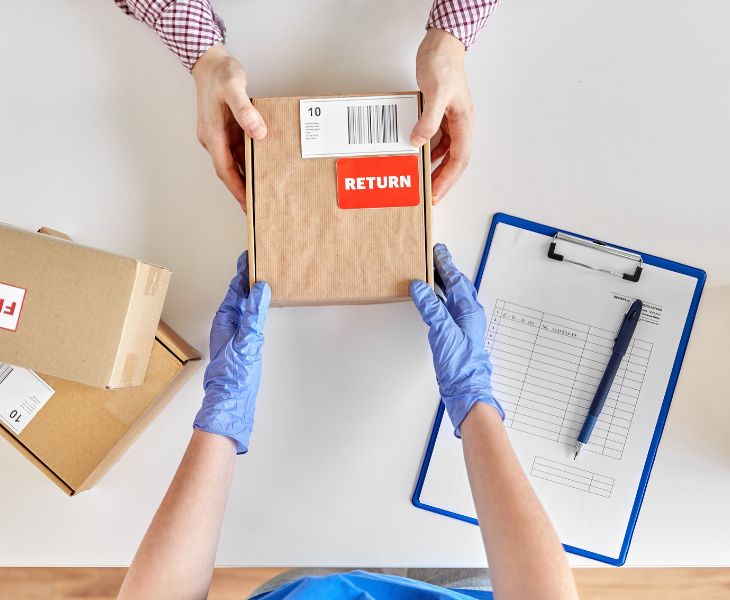Learn how to minimize return rates, handle refund requests efficiently, and improve customer satisfaction for your Amazon business in India.
Returns are an unavoidable part of e-commerce. For Indian Amazon sellers, navigating returns efficiently is critical not just for profitability but also for customer trust. With high return rates and increasing buyer expectations, you need a solid strategy to manage returns while protecting your bottom line.
This guide will walk you through how returns work on Amazon India, how to reduce them, and how to turn return scenarios into opportunities to improve customer satisfaction and brand loyalty.
Why Returns Are a Big Challenge for Indian E-Commerce Sellers
Amazon India offers a generous return policy, especially for categories like fashion, electronics, and home goods. While this builds trust with customers, it puts pressure on sellers who often bear the cost of reverse logistics and refunds.
High return rates can quickly eat into your margins, especially if products come back damaged, or are not eligible for resale. Additionally, frequent returns can lead to negative account health, impact your seller rating, and in worst cases, suspension of listings.
Understanding why customers return products is key. In India, common reasons include wrong product size, product not matching the image, damaged delivery, or unmet expectations due to poor description. By identifying these patterns early, you can take proactive steps to minimize future returns.
Strategies to Reduce Return Rates & Improve Quality Control
Reducing return rates starts with clarity and accuracy. Make sure your product listings are as detailed and accurate as possible. Use high-quality images, clear bullet points, and complete specifications. Avoid exaggeration—only promise what your product can truly deliver.
For apparel or wearable items, include detailed size charts and fitting guidance. If your product needs assembly or has unique usage instructions, provide a guide or link to a how-to video in the listing.
Before dispatching products to Amazon’s fulfillment centers, implement a rigorous quality check process. Make sure your inventory is clean, functional, and packaged securely to avoid damage in transit. A proactive approach to quality can drastically reduce return rates and improve your seller metrics.
Handling Refunds & Replacements Efficiently
Amazon India handles most refunds and replacements directly through its platform. As a seller, your role is to monitor return requests, assess whether the return is valid, and decide whether to accept or dispute the claim.
For FBA sellers, Amazon processes the refund on your behalf, but you must track whether returned items are resellable. If the item is returned damaged or different, you can file for reimbursement under Amazon’s SAFE-T claim system. This is especially useful for getting compensation on high-value items.
For FBM sellers, ensure prompt communication and process refunds quickly to maintain trust. Always follow Amazon’s return window policies and keep documentation of each transaction in case of disputes.
Dealing with Fraudulent Returns & Abuse
Unfortunately, return fraud is a growing issue. Some customers may return used, swapped, or even counterfeit items. Watch out for patterns like multiple returns from the same buyer or high-value products returned in poor condition.
You can report suspicious activity to Amazon using the “Report a Violation” tool or by opening a case through Seller Support. If you’re able to document the issue clearly, Amazon may take action against the buyer.
For FBA sellers, tracking return abuse manually can feel overwhelming — especially at scale. But here’s a simple way to stay in control:
Start by downloading your “FBA Customer Returns Report” weekly from Seller Central. Keep a simple Google Sheet where you log returned orders, the reason for return, and the returned item’s condition (if shown). Look for patterns like frequent “Item not as described” claims or items marked as refunded but never returned.
If an item was damaged, counterfeit, or not returned, file a SAFE-T claim within 60 days to request reimbursement. You can also track this in the same sheet.
Even though Amazon handles fulfillment, being proactive with return data can help reduce abuse and recover lost revenue.
You can build a simple return tracker using Google Sheets or Airtable. If unsure how to start, use tools like ChatGPT to help you structure the sheet and set up alerts for repeat issues.
Turning Returns into an Opportunity for Customer Loyalty
Returns don’t always have to be negative. In fact, how you handle a return can be a chance to build long-term customer trust. By offering polite, prompt service—even when customers are unhappy—you can leave a positive impression.
You can also offer alternatives like store credit or discount coupons for future purchases when the situation allows. This encourages the customer to give your brand another try.
Finally, use insights from return feedback to improve your product design or listing presentation. If customers consistently mention the same problem, address it proactively. Better products mean fewer returns—and more repeat business.
Conclusion
Handling returns effectively is part of running a successful Amazon business in India. While returns can’t be avoided completely, smart sellers know how to reduce them, manage them professionally, and use the experience to improve.
By optimizing listings, ensuring quality, managing refunds, and using tools like SAFE-T claims, you can protect your profit margins and turn returns into a competitive advantage.
Stay informed, stay proactive—and keep your customer experience strong from order to return.







